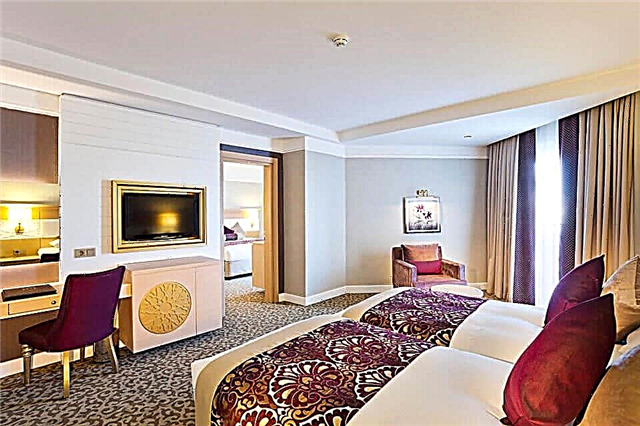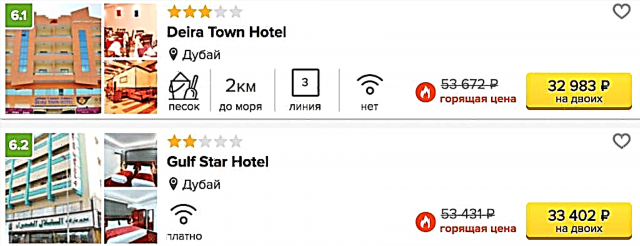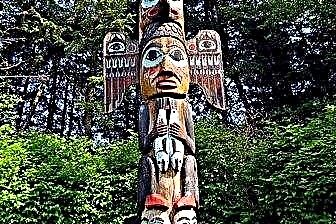Address: Russia, Moscow, Cathedral Square of the Moscow Kremlin
Build date: 1627 year
Architect: John Thaler
Coordinates: 55 ° 45'02.7 "N 37 ° 36'58.0" E
Content:
Walking through the Moscow Kremlin1, one cannot but pay attention to 11 domes shining in gold on thin multi-colored drums. Three combined five-domes are a very unusual architectural solution. The Verkhospassky Cathedral in the 17th century united the house churches of several generations of Russian rulers. And it was built right in the royal chambers - in the Terem Palace.
History of the construction of the Verkhospassky Cathedral
From time immemorial, it was customary for the great dukes and kings to arrange prayer places right in the places where they lived. Because public visits by top officials of the state to religious institutions in ordinary parishes was not always convenient due to excessive human attention and for security reasons.

This is how the royal house churches appeared. In the 17th century, there were already several such churches in the Kremlin, consecrated in honor of the Great Martyr Catherine, the Savior Not Made by Hands, Saint Eudokia and the Exaltation of the Cross (or the Crucifixion of Christ). All of them were of different sizes and stood on the east side on the basements of the large Terem Palace.
The oldest was the brick Catherine Church. It was erected in 1627 on the site of a burnt down wooden church. The construction was supervised by an English architect, the so-called ward master, John Thaler. The Church of Catherine was located on the same level with the Tsaritsyno Golden Chamber and adjoined it from the north. This temple was the main one in the female half, and the queen and princesses traditionally prayed in it. Here they listened to cleansing prayers after childbirth and during fasting.
A few years later, in 1635-1636, with the participation of famous architects Bazhen Ogurtsov, Trefil Sharutin, Antip Konstantinov and Larion Ushakov, the Church of the Savior Not Made by Hands was erected. She became a home church intended for the king and princes.
In 1654, the Church of St. Eudokia was added to the top of the Catherine Church. She, like the Catherine Church, served for the home prayers of the queen and her daughters, that is, it was a women's church. In 1681, the temple of Evdokia was rededicated in honor of the Resurrection of the Word. The most recent, in 1681, was the Church of the Crucifixion built. Its small premises, occupying only 25 sq. m, turned out to be higher than all other terem temples.

At the end of the 17th century, it was decided to unite all the house churches into one building. One of the most authoritative Moscow architects of his time, Osip Dmitrievich Startsev, was appointed to lead this difficult reconstruction. He was born into a family of hereditary builders, and received a large practical school from his father Dmitry Mikhailovich, who built Gostiny Dvors in Arkhangelsk and the Trinity Tower of the Moscow Kremlin.
By 1682, Osip Startsev successfully carried out a radical reconstruction of the facade of buildings and their internal arrangement. The tops of all the churches were leveled with a common cornice and covered with a single copper roof. According to legend, it was forged from depreciated copper money. The graceful drums were decorated with glazed multicolored tiles, which were made according to the drawings of the master from the New Jerusalem Monastery - Elder Hippolytus. And the new eleven-domed cathedral acquired the appearance that we know today.
The history of the temple in the XVIII-XX centuries
The temples gathered under one roof did not cease to fulfill their original purpose. The cathedral served as a place of solitude for the sovereign and his family members for reflection, communion and prayer. Here babies were baptized and prayers were performed in honor of the age of majority of the hereditary princes.

From the cathedral it was possible to climb the stairs to the Boyarskaya platform, which connected the temple and the living quarters of the Terem Palace. This place was intended for public reading of royal decrees, as well as distribution of birthday pies to noble boyars and close friends of the sovereign. Above the stairs leading to the Boyarskaya site, separating the temple from the street, a copper-forged lattice covered with gold leaf was installed. Therefore, in everyday life, the cathedral was spoken of as the Savior behind the Golden bars.
During the Patriotic War of 1812, the cathedral was badly damaged. He lost most of his material assets, and the magnificent murals were badly mutilated by nails. After 14 years, the temple was restored, but with some architectural alterations. And in 1840 the walls of the Catherine Church were painted with new frescoes. Until the beginning of the 20th century, the Verkhospassky Cathedral was opened for all worshipers once a year, on the day of the temple feast.
During an artillery attack in November 1917, shells and shrapnel severely damaged the northwest corner of the building. Large restoration work was carried out in the cathedral in the 20s, 40s and 60s of the XX century. They have largely returned this old architectural structure to its original appearance. The northern facade of the building began to look especially close to the original one. The copper roof, which still covers the cathedral, has been preserved on it since the 18th century.

Interiors and ancient relics of the Verkhospassky Cathedral
Today there are no divine services in the temple. This ancient shrine is closed to the public., as it is part of the residence of the President of Russia.
Some elements of the interior of the 17th century and the decoration of the temple have survived to this day. The gilded wooden iconostases, made in the 17th century by master carvers under the guidance of Klim Mikhailov, have been perfectly preserved. The skillful ornate carving on them is so graceful that outwardly it looks more like mother-of-pearl or porcelain.
Fortunately, very rare icons have survived, made using the applique technique of silk fabrics combined with picturesque images. On these icons, only hands and faces are painted with paint. The clothes and the background are made with silk fabrics, beads and small pearls. Some of the icons of this temple belong to the brush of the famous master of the 17th century Fyodor Evtikhievich Zubov. It also houses beautiful tiled stoves, restored in the 19th century.
Already in the 20th century, a wall painting made in the late 60s of the 17th century by the Moscow painter Simon Fedorovich Ushakov was partially uncovered in the interiors of the cathedral. The chased silver frames of the multi-tiered iconostasis and the royal doors made of silver, dating from the second half of the 18th century, have survived in the church.

Inside the Church of the Crucifixion, a unique large carved crucifix has been preserved, in its size coinciding with the Jerusalem Cross of the Lord, and an iconostasis made of chased copper. And in the Church of the Resurrection of the Word - wooden carved gilded choirs and an old chandelier, donated to Tsar Alexei Mikhailovich by King Charles XI of Sweden. Both these churches are connected by a carved wooden door of amazing beauty and grace. These are the few shrines that miraculously survived the sacking during the war of 1812.
Today, the fabulously beautiful Verkhospassky Cathedral, built during the reign of Tsar Mikhail Fedorovich, is an example of real Moscow architecture. It looks elegant, festively sparkles with its domes and openwork crosses in the sun and pleases the guests of the Moscow Kremlin with the multicolor of skillfully made tiles.











